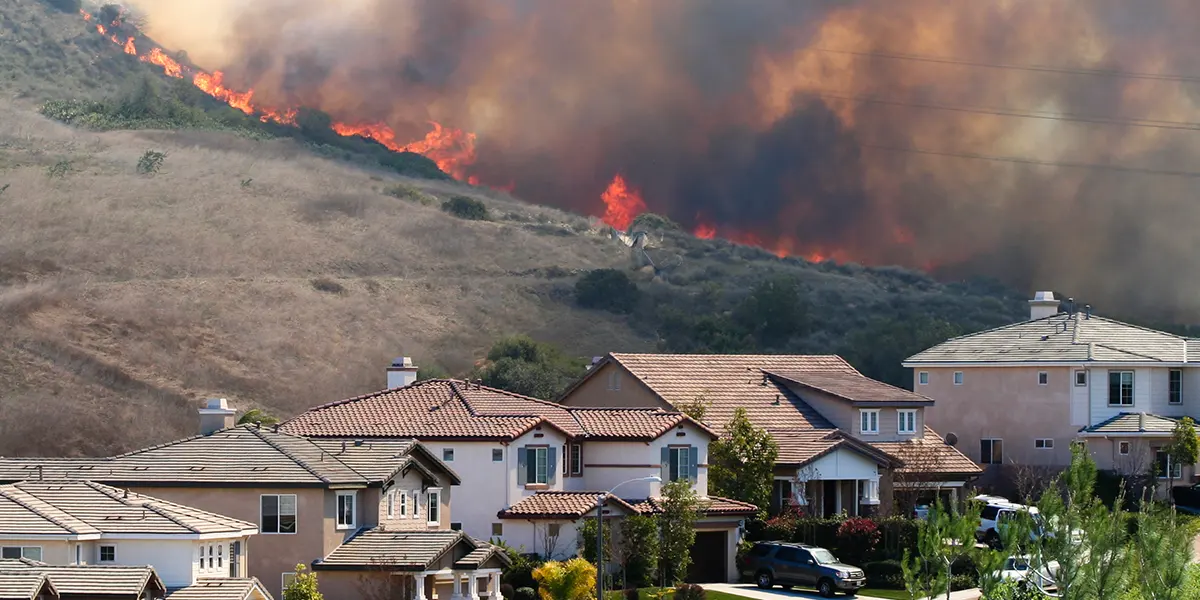Heatwaves, fires, droughts and floods. These are a few of the many risks our planet increasingly faces from climate change that are already visible in the world today.
June marked a significant milestone as it recorded the highest global average temperature ever documented, and this trend of scorching heat waves has carried over into early July. Tragically, these extreme weather events have unleashed torrential rains and devastating floods, leading to numerous casualties and impacting millions of individuals across the United States, Japan, China, and India.
Climate change is here to stay. The crisis has the potential for multifaceted impacts. The outcome of the average surface temperature increasing by 1.5°C in the next 20 years over pre-industrial levels could see 4% of global annual economic output lost by 2050.
In light of this, experts forecast that global financial asset losses will reach $178 trillion by 2070. Furthermore, they estimate that the global gross domestic product (GDP) will reach $103 trillion by the end of 2022.
As we strive to mitigate the climate crisis, adaptation is crucial in addressing climate change's immediate and long-term effects to safeguard existing and future assets. Climate change poses a significant challenge and risk to all industries, prompting the need to adapt to its long-term effects.
What is Going On?
Over the past 800,000 years, our planet has experienced eight cycles of ice ages and warmer periods. However, the activities caused by humans are now greatly accelerating shifts in weather patterns, affecting temperature, precipitation, and wind patterns.
The 10-year average for 2013-2022 is estimated to be 1.14 [1.02 to 1.27] °C above the pre-industrial baseline of 1850-1900, as depicted in Figure 1 below. These profound changes are now deeply embedded in the climate system, even if GHG emissions were to cease tomorrow.
The additional heat trapped in the atmosphere is driving extreme temperature variations at regional and seasonal levels across the globe, intensifying the occurrence of frequent and severe natural disasters. If global warming reaches 1.5°C shortly, it will inevitably escalate in multiple climate hazards.
However, many net-zero targets remain uncertain as the world strives to mitigate the climate crisis.

How Will Climate Change Impact the Globe?
As our planet continues to warm, numerous climate-related changes unfold. Rising temperatures significantly increase the frequency of heat waves, making them increasingly prevalent. Heatwaves have emerged as the most lethal global weather hazard in recent years.
Since 2015, there has been a steady increase in the likelihood of temporarily surpassing the 1.5°C threshold, which was nearly non-existent. Between 2017 and 2021, there was a 10% probability of exceeding this limit. The accompanying chart vividly illustrates a noticeable warming trend, with temperatures in each of the past 45 years surpassing the 20th-century average.
In contrast, during the initial 59-year observation period (1880-1938), global surface temperatures remained below the 20th-century average of 13.9 degrees Celsius.

As the world warms up at a faster rate than at any point before recorded in history, heightening temperatures are changing weather patterns to become more frequent and severe.
In turn, posing many risks for all life forms on Earth evident in Figure 3. Even if we were to halt all emissions today, we would not prevent some changes in climate change.

Climate change affects the climate system in several ways, including warming oceans, warmer land and air and more extreme weather to implicate global physical risks.
Physical risks are both acute and chronic.
- Acute Physical Risks: Driven by an increase in the frequency and severity of extreme weather events.
Examples: storms, cyclones, typhoons, floods, droughts, hurricanes, wildfires, coastal inundation, and extreme precipitation.
Acute physical hazards can be seen in the catastrophic floods of Germany in July 2021 or severe droughts after exceptionally high temperatures and heatwaves during the summer of 2022 in the UK that may remain beyond spring 2023. Climate X is a one-stop shop for all hazard types, including acute physical risks.
- Chronic Physical Risks: Related to more progressive and longer-term shifts in climate patterns over time.
Examples: Rising average temperatures and ocean acidification may lead to chronic climate events such as heat waves, precipitation, desertification, or rising sea levels.

As highlighted below in figure 4, climate risks will interact, which could compound the problem and introduce further complexity. Furthermore, climate risks are significantly more volatile without adaptation action. Any success of adaptation depends upon the level achieved of mitigation.
Although the growing prominence of adaptation as a global challenge with local, national and international dimensions is recognised as equally important to climate change mitigation, adaptation implementation still needs to catch up compared to mitigation actions.
The Big Effect
Climate change inaction could cost the global economy $178 trillion by 2070, resulting in a 7.6% decrease in global GDP. However, if global leaders unite to achieve climate goals, the cost could be reduced to $43 trillion, leading to a 3.8% boost in global GDP.
Furthermore, climate change poses business disruptions, including production and operation disruptions, physical asset damage, changes in demand and supply chain disruptions, and shifts in resource prices.
Consumer preferences are shifting towards climate-friendly choices, with 80% of consumers in significant countries favouring companies with substantial environmental, social, and governance policies. Furthermore, climate change is causing increased human displacement, with millions already internally displaced.
Without decisive action, slow-onset climate change impacts will force 216 million people across six world regions to migrate by 2050. Climate change can deepen poverty and inequality globally, impacting health, livelihoods and exacerbating gender inequalities.
Preparation is Key
Adaptation to climate change is essential for building resilience and minimising the impacts of a changing climate on our planet and society. It is crucial to prioritise and invest in adaptation efforts, enabling communities and ecosystems to adapt to a rapidly changing world. Through collective action and collaboration, we can navigate the path to resilience and secure a sustainable future for future generations.
Organisations must prioritise the inclusion of physical risks in their risk assessment frameworks. Effectively analysing physical climate risks necessitates utilising a diverse set of tools, services, and processes to translate scientific climate data into the language of financial risk management.
This enables informed decision-making and ensures accurate reporting of physical climate risks for financial organisations. However, many organisations must fully integrate physical climate risk into their mainstream risk management processes.
Sources
- Khan, M.R., Munira, S. Climate change adaptation as a global public good: implications for financing. Climatic Change 167, 50 (2021). https://doi.org/10.1007/s10584-021-03195-w
- Basel Committee on Banking Supervision (2021) Climate-related risk drivers and their transmission channels. https://www.bis.org/bcbs/publ/d517.pdf
- Copernicus (2021) Flooding in Europe. https://climate.copernicus.eu/esotc/2021/flooding-july
- IPCC (2022) Climate Change 2022: Impacts, Adaptation and Vulnerability. https://www.ipcc.ch/report/ar6/wg2/downloads/report/IPCC_AR6_WGII_SummaryForPolicymakers.pdf
- Met Office (2023) Effects of climate change. https://www.metoffice.gov.uk/weather/climate-change/effects-of-climate-change
- PwC (2021) Beyond compliance: Consumers and employees want business to do more on ESG. https://www.pwc.com/us/en/services/consulting/library/consumer-intelligence-series/consumer-and-employee-esg-expectations.html
- Statista (2023) Global gross domestic product (GDP) at current prices from 1985 to 2028. https://www.statista.com/statistics/268750/global-gross-domestic-product-gdp/
- The United Nations (2023) Extreme weather highlights need for greater climate action. https://news.un.org/en/story/2023/07/1138712
- The World Economic Forum (2022) How hard could climate change hit the global economy, and where would suffer most? https://www.weforum.org/agenda/2022/04/climate-change-global-gdp-risk/#:~:text=A%20new%20study%20of%20135,South%20Asia%20most%20at%20risk
- UK Government (2022) All of England’s South West region now in drought. https://www.gov.uk/government/news/all-of-england-s-south-west-region-now-in-drought
- UK Government (2022) National Drought Group forecasts drought may remain beyond spring 2023. https://www.gov.uk/government/news/national-drought-group-forecasts-drought-may-remain-beyond-spring-2023
- World Bank (2020) Global Action Urgently Needed to Halt Historic Threats to Poverty Reduction. https://www.worldbank.org/en/news/feature/2020/10/07/global-action-urgently-needed-to-halt-historic-threats-to-poverty-reduction
- World Meteorological Organization (2022) Eight warmest years on record witness upsurge in climate change impacts. https://public.wmo.int/en/media/press-release/eight-warmest-years-record-witness-upsurge-climate-change-impacts
- World Meteorological Organization (2023) WMO Global Annual to Decadal Climate Update (Target years: 2023-2027). https://library.wmo.int/index.php?lvl=notice_display&id=22272





